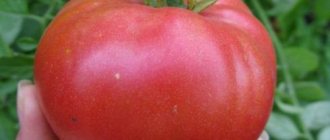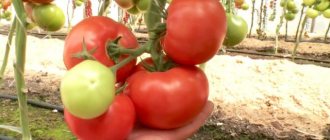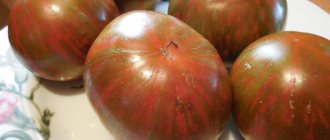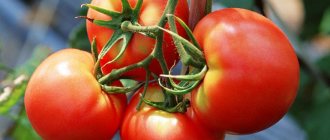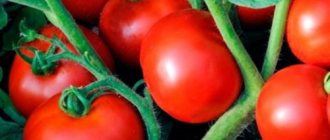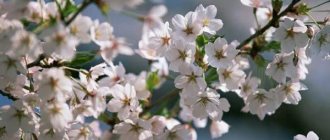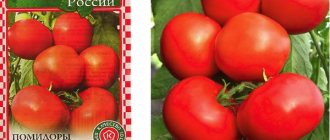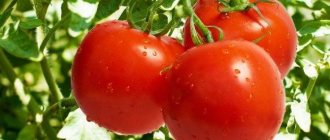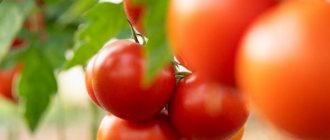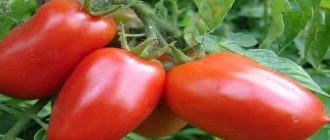Winter cherry f1 is an excellent choice for cherry lovers. It grows in open beds and presents an unusual appearance with abundant, cascading clusters of fruit.
| Height | Landing location | Ripening time | Fruit color | Fruit size | Origin | Fruit shape |
| Medium height | Greenhouse, Open ground | Early ripening | Reds | Small | Variety | Round |
Description of the variety
Short review:
“Winter Cherry” is an early cherry tomato with a determinate growth pattern. The standard compact bush grows no more than 70 cm in height.
The first brush is placed under leaves 9-11. The remaining brushes are formed every 3 sheets.
Characteristics of “Winter Cherry” tomatoes:
- Round shape;
- Slight flattening on the sides;
- Rich dark crimson color;
REFERENCE: Observable cherry varieties are quite large in size - their weight can reach 110 grams.
- Juicy and dense pulp;
- 3-5 seed chambers;
- The fruits contain a small number of seeds;
- The dry matter content is about 7%;
- Long shelf life at home.
Productivity, description and characteristics of the Winter Cherry tomato variety
An unpretentious early-ripening hybrid, Winter Cherry f1 tomato, bred for the northern regions. Where weather conditions are unstable, and most often tomatoes do not have time to ripen.
What is the species
Taking into account the characteristics of the variety will help the beginning gardener avoid mistakes when growing tomatoes. By properly caring for and carrying out agrotechnical work in a timely manner, you can get a good harvest.
- Bush: standard, indeterminate.
- Inflorescence: intermediate.
- First inflorescence: above the 10th leaf.
- Number of tomatoes per brush: 17-20 pcs.
- Ripening time: 95 days (from the moment of sowing the seeds).
- Color: red, deep crimson.
- Shape: round.
- Weight: 30 gr.
- Number of cameras: from 2 to 5.
- Taste: excellent.
- Density: high.
- Transportability: good.
- Shelf life: up to 2 months in a cool place.
Planting and care
The unpretentious variety of tomatoes “Winter Cherry” does not have any peculiarities in the growing process. They mainly use the seedling method. Seeds are planted in early April. After the appearance of the second full leaf, picking is carried out.
Planted in the ground in early June. By this point, the tomatoes should have 5-6 leaves.
Tomatoes: advantages and disadvantages
As a disadvantage of the review variety, not very good yield is noted due to the limited number of brushes on the bush.
The main positive properties of “Winter Cherry” tomatoes:
- Strong immunity to diseases, pests and fungi;
- Ripe fruits do not crack;
- High resistance to cold;
- Undemanding to soil nutrition;
- Very sweet tomato taste;
- Universal use of fruits;
- No need for pinching and tying up the bush;
- Early ripening of the crop;
- Excellent transportability.
Tomato Winter Cherry - description of the variety and growing technology
Growing low-growing tomatoes has its advantages. The weather is not always stable and sometimes tall varieties do not have time to fully produce their harvest.
And the standard and unpretentious varieties bear fruit no worse than their tall counterparts, and besides, they ripen early and smoothly. One of these varieties is the Winter Cherry tomato.
Description of the variety
Seeds for growing tomatoes Winter cherry (photo)
Winter cherry is an early ripening tomato that does not require pinching. The average ripening period, according to the description and reviews, is 105 days. The fruits are smooth, rich crimson in color, their average weight is 100 g. The main purpose of the variety is cultivation in open ground.
- Very sweet fruits.
- Not affected by late blight.
- The fruits are resistant to cracking.
Tomatoes of this variety can be consumed fresh, for cooking, and also used for preparations.
Sowing seedlings
It is recommended to grow this tomato variety through seedlings. To do this, in the second half of March or mid-April, the seeds are sown in seedling boxes with loose and fertile soil. Containers must be kept at a temperature of +25-27°C until germination. After the first shoots appear, the boxes are moved to a well-lit place, and the temperature is reduced to 20-22°C.
After the second true leaf appears on the seedlings, they begin to pick them into larger containers or into separate cups. Before planting in open ground, seedlings must be hardened off. To do this, a week before the scheduled date, the boxes are taken out to the veranda or balcony for a day.
I have a large garden and vegetable garden, several greenhouses. I love modern methods of cultivating plants and mulching the soil, and I share my experience.
If you decide to grow this variety of tomatoes in seedlings, we recommend starting with choosing a container. This can be a plastic or wooden box at least 5 cm deep. It can be either solid or mesh. In the first case, drainage holes need to be made in the bottom. It is better to make them small, but in sufficient quantity and evenly over the entire bottom area.
If the box or other container is lattice, then agrofibre or film can be laid on the bottom. If film is chosen, it is also worth making slits or other holes in it for good moisture drainage.
The next step is laying the drainage layer. Very small pebbles and old sawdust work well. You can prepare a soil mixture from garden or forest soil (the base of the mixture should make up more than half of the total substrate), rotted humus and deoxidized peat. You can add a little sand.
When the soil is mixed it needs to be disinfected. We recommend pouring boiling water over it with dissolved dry boric acid. The proportion is 2 grams per 10 liters.
It is better to make small holes or grooves for planting seeds. Planting depth is 0.5-1 cm. When sowing, it is better to maintain a distance of 2 cm both between the seeds and in the row. It is important that the plants have enough space and do not compete for light or nutrients.
Crops need to be covered with plastic film to create a greenhouse effect, and watered as the soil dries. When the first shoots appear, the film is removed. Otherwise, the tomatoes will be thin, pale and elongated. When growing in an apartment, you need to change the position of the box every few days so that the light falls evenly on all the seedlings.
When the plants get a little stronger, we recommend watering them at least once with a weak solution of manganese. This will protect the plant from fungus, which often affects seedlings at home.
You can start picking seedlings at the age of cotyledons, but it is better to wait until they become a little larger and stronger. This will make the procedure easier. It is better to pick in peat tablets or special cups. Toga planting in the ground or greenhouse can be done by transshipment, and this is less traumatic for the plants.
Hardening is indeed very important, but it must be done gradually. On the first day, it is better to take the tomatoes to a quiet corner with diffused light and leave them there for 1.5-2 hours. Every day the walking time needs to be increased. Immediately before planting, the seedlings should spend several nights outside.
Growing and care
In the second half of May, the grown plants are planted in open ground. By the time of planting, high-quality seedlings should have 5-6 true leaves and the beginning of a flower tassel. It should look quite strong and stocky.
It is best to choose an open and sunny place for growing tomatoes with fairly fertile soil. The best precursors for tomatoes are cabbage, onions or carrots. It is not advisable to plant tomatoes after other crops from the nightshade family, as they have common diseases.
When planting, the distance between plants should be about 25 cm. And between rows about 40 cm.
Containers with seedlings should be well watered before starting work. This will allow less damage to the plant root system.
Tomato fruits in summer (photo)
At the end of the planting work, the beds must be shaded, this will allow injured plants to quickly take root in a new place. To do this, you can use non-woven covering material Acrylic or Spunbond.
10 days after planting the seedlings in a permanent place, they must be fed with nitrogen fertilizer. For example, you can use urea, dilute it at the rate of a matchbox per bucket of water.
You should also not forget about timely weeding and loosening the soil after watering. To reduce labor costs, these two types of work can be combined. Using mulch also gives good results.
A layer of mulching material has the ability not only to retain moisture in the soil, but also to protect the beds from the formation of soil crust and from the germination of weeds.
Tomatoes are a moisture-loving crop. Therefore, they need to be watered regularly. In this case, watering must be carried out at the root, since water getting on the leaves and flowers can provoke a premature outbreak of late blight.
The Winter Cherry tomato, according to its characteristics, practically does not form stepsons and has a small bush height. Therefore, there is no need for gartering and pinching it.
Tomatoes are very responsive to organic fertilizers, so during the summer they can be fertilized 2-3 times with mullein infusion. This will significantly increase productivity. In this case, the timing of fertilizing should coincide with the beginning of mass flowering and fruit formation.
In order for as many tomatoes as possible to ripen on each bush, it is imperative to remove fruits that have just begun to turn brown. This is especially true for the northern regions, where the first frosts may begin in the second half of August.
Pests and diseases
Good tomato harvest
The most common disease of tomatoes is late blight. Winter cherries are an early ripening variety and therefore usually have time to bear fruit before the spread of this disease.
But in some years even it can be subject to late blight. In this case, the plants need to be treated with copper-containing fungicides. For example, you can use “Profit Gold”.
The most common pest found on this tomato planting is aphids. It's very easy to fight her. In most cases, just one treatment with a systemic insecticide is sufficient.
In cases where fruits have already formed on the bushes, chemicals cannot be used. In this case, the treatment is carried out with a solution of laundry soap.
While watching the video you will learn about caring for tomatoes.
Before immersing seeds in the soil, they can be disinfected with a manganese solution and treated with a growth preparation so that seedlings are vigorous and fast.
Sowing seeds is carried out in the following order:
- The soil is thoroughly moistened with lukewarm water.
- Make shallow holes.
- Infrequently, seeds are placed and sprinkled with soil on top.
- As the seedlings grow, care is taken. Water the plants as needed.
Tomato seedlings of the Red Cherry variety begin to be transplanted in early June. At this time, the weather is warm, there are no night frosts and 6-7 leaves are formed on the sprout.
The tomatoes are transplanted into pre-dug holes, into which the stem is immersed to almost half its length. If necessary, cut off the lower leaves. The hole is filled with soil from above and compacted a little. Afterwards, watering is carried out and as the plants grow and develop, certain care is carried out.
Plant care technology
The Red Cherry tomato variety tolerates temperature changes well, but is still a demanding plant. To achieve a rich harvest of cherry tomatoes, it is necessary to maintain sufficient light, temperature and humidity. It is also important to water the beds in a timely manner, dig and weed holes, apply fertilizers, tie up and pick up plantings, and fight pests and diseases.
It is recommended to water vegetables not often, about 2 times a week, but quite generously. In some cases, the frequency of watering can be increased, it all depends on weather conditions and territorial features.
As the tomato grows and develops, it should be tied up and mulched. It is advisable to do this every 2 weeks. For accelerated growth and good formation of tomato ovaries, it is necessary to fertilize at least 3 times. They must be organic and mineral (phosphorus, nitrogen, magnesium and potassium compounds, superphosphate, wood ash and other preparations).
The fight against diseases and pests consists of pollinating plants with special preparations and observing timely care.
Pests and diseases
Red Cherry tomatoes, like other vegetables, are susceptible to various diseases. Especially often you can notice the development of black leg, rot, mosaic or spotting, which develop as a result of insufficient care of plantings.
The most common pests are mole crickets, aphids, wireworms and whiteflies.
Good tomato harvest
The most common disease of tomatoes is late blight. Winter cherries are an early ripening variety and therefore usually have time to bear fruit before the spread of this disease.
But in some years even it can be subject to late blight. In this case, the plants need to be treated with copper-containing fungicides. For example, you can use “Profit Gold”.
The most common pest found on this tomato planting is aphids. It's very easy to fight her. In most cases, just one treatment with a systemic insecticide is sufficient.
In cases where fruits have already formed on the bushes, chemicals cannot be used. In this case, the treatment is carried out with a solution of laundry soap.
While watching the video you will learn about caring for tomatoes.
The Winter Cherry variety is an example of a resistant tomato variety. It can be grown without any problems even in the northern regions of the country.
Noticed a mistake? Select it and press Ctrl Enter to tell us.
Attention, super FLIGHT!
Positive and negative characteristics of the variety
“Winter Cherry” tomatoes have a large number of positive features, which is why they are valued by summer residents.
- The fruits do not crack.
- Long shelf life.
- Excellent transportability.
- Versatility of use.
- Great taste.
- Disease resistance.
- Cold resistance.
- Unpretentiousness.
- Compared to other species, low yield.
Sowing seedlings
It is recommended to grow this tomato variety through seedlings. To do this, in the second half of March or mid-April, the seeds are sown in seedling boxes with loose and fertile soil. Containers must be kept at a temperature of 25-27°C until germination. After the first shoots appear, the boxes are moved to a well-lit place, and the temperature is reduced to 20-22°C.
After the second true leaf appears on the seedlings, they begin to pick them into larger containers or into separate cups. Before planting in open ground, seedlings must be hardened off. To do this, a week before the scheduled date, the boxes are taken out to the veranda or balcony for a day.
I have a large garden and vegetable garden, several greenhouses. I love modern methods of cultivating plants and mulching the soil, and I share my experience.
If you decide to grow this variety of tomatoes in seedlings, we recommend starting with choosing a container. This can be a plastic or wooden box at least 5 cm deep. It can be either solid or mesh. In the first case, drainage holes need to be made in the bottom. It is better to make them small, but in sufficient quantity and evenly over the entire bottom area.
If the box or other container is lattice, then agrofibre or film can be laid on the bottom. If film is chosen, it is also worth making slits or other holes in it for good moisture drainage.
The next step is laying the drainage layer. Very small pebbles and old sawdust work well. You can prepare a soil mixture from garden or forest soil (the base of the mixture should make up more than half of the total substrate), rotted humus and deoxidized peat. You can add a little sand.
When the soil is mixed it needs to be disinfected. We recommend pouring boiling water over it with dissolved dry boric acid. The proportion is 2 grams per 10 liters.
It is better to make small holes or grooves for planting seeds. Planting depth is 0.5-1 cm. When sowing, it is better to maintain a distance of 2 cm both between the seeds and in the row. It is important that the plants have enough space and do not compete for light or nutrients.
Crops need to be covered with plastic film to create a greenhouse effect, and watered as the soil dries. When the first shoots appear, the film is removed. Otherwise, the tomatoes will be thin, pale and elongated. When growing in an apartment, you need to change the position of the box every few days so that the light falls evenly on all the seedlings.
When the plants get a little stronger, we recommend watering them at least once with a weak solution of manganese. This will protect the plant from fungus, which often affects seedlings at home.
You can start picking seedlings at the age of cotyledons, but it is better to wait until they become a little larger and stronger. This will make the procedure easier. It is better to pick in peat tablets or special cups. Toga planting in the ground or greenhouse can be done by transshipment, and this is less traumatic for the plants.
Hardening is indeed very important, but it must be done gradually. On the first day, it is better to take the tomatoes to a quiet corner with diffused light and leave them there for 1.5-2 hours. Every day the walking time needs to be increased. Immediately before planting, the seedlings should spend several nights outside.
The opinion of summer residents regarding the “Winter Cherry” tomato
To understand what a certain variety of tomato is, a novice summer resident looks for answers on the Internet. Reviews provide more useful information.
- Hope. A resistant plant, very hardy and unpretentious. Many tomatoes died from tobacco mosaic. The “Winter's Tale” tomato survived and produced flowers and fruits. The yield is not bad.
- Valentina. This was my first time trying to plant this type of tomato. Everything turned out great. The tomatoes went especially well in jars for pickling. The description was completely confirmed. The tomato is worthy of praise.
Summer residents appreciate “Winter Cherry” tomatoes for their unpretentiousness and the low amount of physical effort required to care for the bushes. There is no need to spend extra time shaping and tying up the plant. And the taste qualities are left behind by some varieties of tomatoes.
Growing tomatoes
The variety is grown by seedlings.
How to prepare seeds?
Before planting, you must carefully sort out the planting material. Seedlings should be grown only from dense and whole seeds.
Selected seeds are disinfected in a weak solution of manganese.
IMPORTANT: Additional treatment with biostimulants will provide the planting material with better germination.
Sowing seed material
The seeds are planted for seedlings in early April. Shallow boxes are filled with light and nutritious soil. The seeds are deepened into the soil 1.5-2 cm, sprinkled with warm water and covered with film or thin glass. To germinate planting material, containers are placed in a room with a temperature within 23-25 degrees Celsius.
As soon as the first shoots appear, the boxes are freed from film or glass and placed on a windowsill well lit by sunlight.
After the first true leaves appear, the plants are planted in separate pots. During growth, seedlings need fertilizing with mineral fertilizers and regular watering.
Rules for planting seedlings
Bushes are planted in garden beds at the beginning of summer. At this point, the plants should have 5-6 true leaves. The place for planting Winter Cherry tomatoes should be sunny, protected from drafts and wind. The recommended distance between bushes is about 25 cm. Per 1 sq. 5-7 tomatoes are planted per meter.
The plant does not form lateral shoots (stepchildren), and its stem grows in thickness throughout the season. Therefore, tomatoes do not need pinching and tying to trellises.
Features of cultivation and storage
Seeds are sown in the 1st-2nd decade of March. Take loose turf soil for planting.
The seeding depth is 1.5 cm; the seeds are sprinkled with finely dispersed soil mixture on top. Compact the soil.
How to care for seedlings:
- hardening 1 week;
- diving with 2 true leaves;
- feeding with liquid solutions “Agricol” and “Krepysh”.
Tomatoes are stored for 1.5-2 months in dark, dry, cool rooms. Recommended for growing for sale.
Bush care
Basic recommendations for caring for “Winter Cherry” plants:
- Moderate watering with settled water;
- Loosening the soil in an area planted with tomatoes;
- Timely weeding;
- Feeding tomatoes with organic fertilizers and mineral complexes.
IMPORTANT: To increase the stability of the bushes and nutrition of ripening fruits, plants should be periodically earthed up.
Tomatoes "Winter Cherry" prefer organic fertilizers:
- Mullein infusion;
- Humus;
- Bird droppings;
- Rotted plant remains.
Organic matter is added to the soil during its loosening and after watering the plants.
Tomato Winter cherry: characteristics and description of the variety with photos
The Winter Cherry tomato was bred by Russian breeding specialists in 1998. The plant is a standard cherry tomato. Initially, it was conceived for cultivation under the climatic conditions of the central and northern zones of Russia.
Characteristics of the variety
Description of tomato Winter cherry
Recommendations for planting
“Winter cherry” does not have any special features during the growing process. The standard method is seedling. The seeds are planted in early April. As soon as 2 full sheets appear, a pick should be made. It is recommended to plant in the ground if there are 5 - 6 leaves in early June. You can do without stepsoning. There is no need to tie the garter to the support. Since “Winter Cherry” does not form lateral branches from below, and the trunk constantly grows in width.
Choose a sunny planting location. The distance between the bushes is 25 - 30 cm. And maintaining about 40 cm between the rows. For 1 sq. you can plant 7 - 10 plants.
Care
Do not forget about regular weeding, loosening and the use of organic fertilizers. Especially before flowering and the beginning of the ripening of the first fruits.
“Winter cherry” prefers organic fertilizers from rotted manure or plant residues, which are added to the soil during loosening and watering. Water as the soil dries out.
Usually, the “Winter Cherry” tomato manages to bear fruit before virus outbreaks, but if the disease suddenly catches on, it is enough to treat it with fungicides that contain copper. To prevent aphids, a single treatment with an insecticide or an infusion of wormwood with garlic is sufficient.
Reviews from those who planted
I live in the south of Siberia. “Winter cherry” was planted in open ground and not even covered with anything. Sometimes she brought in horse manure and loosened it. The tomatoes ripened without getting sick. This is what I like about them, that they are unpretentious, and my neighbor’s even recovered after a little freezing. We ate the first fruit at the end of June. On one brush there were 10 - 15 pieces of 2 - 3 cm each. They are irreplaceable in conservation, they are very convenient for filling voids in jars.
This is not the first time I plant them. I sow the seeds in a dense hole with a small sprinkle of compost and sand. At first I sprayed it with a spray bottle so as not to wash away my work. As it grew, I removed dried and limp leaves, and made sure that others did not touch the ground - so as not to catch the fungus. I like the fact that the brushes retain their appearance for a long time. They ripened together and did not crack. In mid-July I began to taste the first fruits.
Diseases and pests
The review variety is resistant to the following dangerous diseases:
- Fusarium;
- Cladosporiosis;
- Tobacco mosaic virus;
- Powdery mildew.
During an epidemic of late blight and other fungal infections, tomatoes completely lose their harvest. If the plants are still infected with late blight, they are treated with preparations with a high copper content.
Of the insects, only aphids are dangerous to tomatoes. The pest is destroyed using traditional methods: plants are sprayed with soapy water, infusions of wormwood or garlic. When aphids appear en masse, the plantings are treated with special insecticides.
Tomato Winter cherry - description and characteristics of the variety
Characteristics of the variety
The category is determinate and early ripening. The ripening period is about 105 days. The bush grows small, no more than 70 centimeters in height. You can raise it in open beds. The variety is resistant to viruses and diseases, but tobacco mosaic, powdery mildew, and cladosporiosis are at risk.
From each bush you can only harvest up to 2.5 kilograms of crop. With high-quality care, compliance with growing rules, and soil fertility, the amount of harvest collected from each plant can reach 3.7 kilograms of tomatoes.
The main characteristic of this type of vegetable crop is good frost resistance and unpretentiousness to elevated temperatures and nutritional qualities of the estate.
Since when growing there is no need to carry out some agrotechnical procedures, and most importantly - to pin the plant and tie it up, caring for the Winter Cherry tomato variety does not take much time and effort from the gardener.
Description of the harvest
Eggs of this type are small, round in shape, slightly flattened at the ends. The pulp and skin are dark crimson in color. Ass Winter cherries are larger than other cherries - the prestige of one fruit is about 110 grams. In addition, such assholes are more fleshy.
Each fruit contains 3-5 chambers, there are only a few seeds in them and they are quite small. Tomatoes store well, remaining fresh for up to two months (if stored in a cool place). These eggs are consumed fresh and used to prepare salads and other dishes. In addition, Winter cherries are great for pickling and pickling.
Successes and disadvantages
The main positive quality of Winter cherries is that when growing this variety, the plant does not need to be tied up or pinched. The trunks of the bushes are no longer strong, so there is no need to hill them, in the hope of preventing breakages when the fruits are filled.
Without taking this into account, numerous positive reviews from gardeners indicate that tomatoes of this variety have an excellent taste and can be stored for a long time.
The negative side is that the yield is rather low, because not many brushes grow on each bush.
Recommendations for growing associations
The variety is grown from seedlings. Seeds should be planted in early April. It is recommended to plant the rudiments in a permanent place no earlier than the second ten days of July. Before the plant is transplanted into open ground, the seedlings must be picked.
The commutation of planting in the garden is as follows: between bushes it is appropriate to maintain a distance of about 25 centimeters, between rows from 35 to 45 centimeters. When the plant is actively growing, a large number of lower leaves and extra shoots are not formed, and the stem of the bush grows in thickness throughout the season. As a result, when growing tomatoes of this variety, there is no need to neglect such agrotechnical measures as gartering and removing shoots.
In order to increase the stability of the crop and the nutrition of ripening tomatoes, it is recommended to hill up the plant from time to time. The variety responds well to fertilizing with organic fertilizers prepared from diluted mullein or rotted plant residues or manure. Experienced gardeners fertilize the plantings, in some cases water the beds or loosen them.
Diseases and pests
The category is practically not susceptible to diseases or pests, due to the fruits ripening early. When numerous outbreaks of late blight and other fungal infections are observed, the entire crop is removed from the beds. Among insects, only aphids can cause harm. You can fight it using folk methods (garlic infusion or wormwood) and insecticidal agents.
Winter cherries are considered an excellent option for growing in regions with cool climates. During the Indus season with unfavorable weather conditions, you can collect a large quantity of tomatoes with excellent taste.
Care
Do not forget about regular weeding, loosening and the use of organic fertilizers. Especially before flowering and the beginning of the ripening of the first fruits.
“Winter cherry” prefers organic fertilizers from rotted manure or plant residues, which are added to the soil during loosening and watering. Water as the soil dries out.
Usually, the “Winter Cherry” tomato manages to bear fruit before virus outbreaks, but if the disease suddenly catches on, it is enough to treat it with fungicides that contain copper. To prevent aphids, a single treatment with an insecticide or an infusion of wormwood with garlic is sufficient.
Description of the harvest
Eggs of this type are small, round in shape, slightly flattened at the ends.
The pulp and skin are dark crimson in color. Ass Winter cherries are larger than other cherries - the prestige of one fruit is about 110 grams. In addition, such assholes are more fleshy. Each fruit contains 3-5 chambers, there are only a few seeds in them and they are quite small. Tomatoes store well, remaining fresh for up to two months (if stored in a cool place). These eggs are consumed fresh and used to prepare salads and other dishes. In addition, Winter cherries are great for pickling and pickling.
An unpretentious early-ripening hybrid, Winter Cherry f1 tomato, bred for the northern regions. Where weather conditions are unstable, and most often tomatoes do not have time to ripen.
Taking into account the characteristics of the variety will help the beginning gardener avoid mistakes when growing tomatoes. By properly caring for and carrying out agrotechnical work in a timely manner, you can get a good harvest.
- Bush: standard, indeterminate.
- Inflorescence: intermediate.
- First inflorescence: above the 10th leaf.
- Number of tomatoes per brush: 17-20 pcs.
- Ripening time: 95 days (from the moment of sowing the seeds).
- Color: red, deep crimson.
- Shape: round.
- Weight: 30 gr.
- Number of cameras: from 2 to 5.
- Taste: excellent.
- Density: high.
- Transportability: good.
- Shelf life: up to 2 months in a cool place.
Planting and care
The unpretentious variety of tomatoes “Winter Cherry” does not have any peculiarities in the growing process. They mainly use the seedling method. Seeds are planted in early April. After the appearance of the second full leaf, picking is carried out.
Planted in the ground in early June. By this point, the tomatoes should have 5-6 leaves.
No pinning required. Garter to a trellis or support if desired.
When growing tomatoes of any variety, one should not forget about timely weeding, loosening and introducing fertilizers. It is best to do this before flowering and before the fruits begin to ripen.
Growing "Winter's Tale" in greenhouses is also practiced.
Early ripening tomatoes “Winter's Tale” are practically not susceptible to the main disease of the crop, late blight. Most often, they manage to bear fruit before its mass distribution.
If the plant does become infected, it can be treated with fungicides containing copper.
On plants with fruits, it is best to destroy pests using folk remedies.
Tomatoes are resistant to the following diseases:
- Powdery mildew.
- Cladosporiosis.
- Tobacco mosaic.
- Fusarium wilt.
From one plant you can get up to 2.5 kg of tomatoes. But if you care for the plant according to all agrotechnical standards, the yield will increase. On average, from 1 m2 you can harvest up to 10 kg of tomatoes.
“Winter Cherry” tomatoes have a large number of positive features, which is why they are valued by summer residents.
- The fruits do not crack.
- Long shelf life.
- Excellent transportability.
- Versatility of use.
- Great taste.
- Disease resistance.
- Cold resistance.
- Unpretentiousness.
- Compared to other species, low yield.
To understand what a certain variety of tomato is, a novice summer resident looks for answers on the Internet. Reviews provide more useful information.
- Hope. A resistant plant, very hardy and unpretentious. Many tomatoes died from tobacco mosaic. The “Winter's Tale” tomato survived and produced flowers and fruits. The yield is not bad.
- Valentina. This was my first time trying to plant this type of tomato. Everything turned out great. The tomatoes went especially well in jars for pickling. The description was completely confirmed. The tomato is worthy of praise.
Summer residents appreciate “Winter Cherry” tomatoes for their unpretentiousness and the low amount of physical effort required to care for the bushes. There is no need to spend extra time shaping and tying up the plant. And the taste qualities are left behind by some varieties of tomatoes.
The red cherry tomato variety is characterized by excellent productivity. With proper care and cultivation, you can get up to 2-2.5 kg of vegetables from one bush. In areas with warm climates, tomatoes can be planted up to 2 times a year.
Today, breeders have developed many varieties of tomatoes from the cherry series, so beloved by gardeners. These small, cute and sweet tomatoes can be grown in open ground, in greenhouses, and even at home. Red cherries are one of the classic varieties of this dessert series, consistently producing high yields and not requiring increased care requirements.
This tall variety is not a hybrid, as many people mistakenly think, confusing it with its hybrid counterpart - Winter Cherry tomatoes. Has high yields. From the moment of planting to harvest, an average of 85-100 days pass, which allows us to classify this species as an early-ripening crop.
Fruiting is uniform, the ovaries are formed not individually, but in clusters, which greatly facilitates harvesting. It has a long shelf life without loss of shape, taste or appearance, but does not tolerate transportation very well.
The advantages of the variety certainly outweigh the disadvantages. The main ones are:
- Excellent taste with a pleasant sweet note.
- Fast maturation.
- Decorative.
- Unpretentiousness in relation to weather conditions.
- Resistant to pests, rot and common diseases.
- High keeping quality.
- Suitability for whole-fruit canning.
READ MORE: Cucumber Siberian Garland F1 - description of the variety with photos
Winter Cherry tomatoes are bred specifically for cultivation in regions with cold climates. Plants tolerate changes in weather conditions well and are unpretentious in care. The fruits have a very pleasant sweet taste.
Tomatoes were bred by Russian breeders. The variety was officially registered in 1998.
Description of the variety
“Winter Cherry” is an early cherry tomato with a determinate growth pattern. The standard compact bush grows no more than 70 cm in height.
The first brush is placed under leaves 9-11. The remaining brushes are formed every 3 sheets.
Characteristics of “Winter Cherry” tomatoes:
- Round shape;
- Slight flattening on the sides;
- Rich dark crimson color;
- Juicy and dense pulp;
- 3-5 seed chambers;
- The fruits contain a small number of seeds;
- The dry matter content is about 7%;
- Long shelf life at home.
The main positive properties of “Winter Cherry” tomatoes:
- Strong immunity to diseases, pests and fungi;
- Ripe fruits do not crack;
- High resistance to cold;
- Undemanding to soil nutrition;
- Very sweet tomato taste;
- Universal use of fruits;
- No need for pinching and tying up the bush;
- Early ripening of the crop;
- Excellent transportability.
Application of fruits
Due to their excellent taste, Winter Cherry tomatoes are ideal for eating fresh. Vegetable salads and snacks are prepared from the fruits of the review variety; they are used as ingredients in the preparation of various first and second courses. Tomatoes are indispensable for whole-fruit canning.
The variety is grown by seedlings.
Before planting, you must carefully sort out the planting material. Seedlings should be grown only from dense and whole seeds.
Selected seeds are disinfected in a weak solution of manganese.
The seeds are planted for seedlings in early April. Shallow boxes are filled with light and nutritious soil. The seeds are deepened into the soil 1.5-2 cm, sprinkled with warm water and covered with film or thin glass. To germinate planting material, containers are placed in a room with a temperature within 23-25 degrees Celsius.
As soon as the first shoots appear, the boxes are freed from film or glass and placed on a windowsill well lit by sunlight.
After the first true leaves appear, the plants are planted in separate pots. During growth, seedlings need fertilizing with mineral fertilizers and regular watering.
Bushes are planted in garden beds at the beginning of summer. At this point, the plants should have 5-6 true leaves. The place for planting Winter Cherry tomatoes should be sunny, protected from drafts and wind. The recommended distance between bushes is about 25 cm. Per 1 sq. 5-7 tomatoes are planted per meter.
The plant does not form lateral shoots (stepchildren), and its stem grows in thickness throughout the season. Therefore, tomatoes do not need pinching and tying to trellises.
Bush care
Basic recommendations for caring for “Winter Cherry” plants:
- Moderate watering with settled water;
- Loosening the soil in an area planted with tomatoes;
- Timely weeding;
- Feeding tomatoes with organic fertilizers and mineral complexes.
Tomatoes "Winter Cherry" prefer organic fertilizers:
- Mullein infusion;
- Humus;
- Bird droppings;
- Rotted plant remains.
Organic matter is added to the soil during its loosening and after watering the plants.
Diseases and pests
The review variety is resistant to the following dangerous diseases:
- Fusarium;
- Cladosporiosis;
- Tobacco mosaic virus;
- Powdery mildew.
During an epidemic of late blight and other fungal infections, tomatoes completely lose their harvest. If the plants are still infected with late blight, they are treated with preparations with a high copper content.
Of the insects, only aphids are dangerous to tomatoes. The pest is destroyed using traditional methods: plants are sprayed with soapy water, infusions of wormwood or garlic. When aphids appear en masse, the plantings are treated with special insecticides.
Productivity
Tomatoes are not characterized by very high yields - about 2.5 kg per bush.
The “Winter Cherry” variety was originally created by breeders for cultivation in the northern and middle climatic zones. Tomatoes tolerate cold weather well and are successfully grown in unprotected soil even in Siberia and the Urals.
Growing
The first reason why gardeners choose the Red Cherry tomato is that growing it will not be particularly difficult. Red cherry tomatoes, like many other types, are most often grown using seedlings. But in order to get it, you need to immediately sow the seeds.
Growing seedlings
To plant a variety, only viable seeds must be selected. Then, the day before planting, they must be treated with a solution of potassium permanganate. The soil in which the cherry tomatoes will be planted also plays an important role. It should have neutral acidity and be quite nutritious.
Such land can be purchased at a specialized store or made independently. To do this, you just need to mix black soil with sand. You also need to prepare a container in which the tomatoes will be planted. Now plant the seeds and cover the container with a plastic bag. The red cherry will remain in this state until sprouts appear.
Plants require careful care
As soon as the seeds hatch, the bag will need to be removed. Now the moment has come when you should carefully care for your tomato.
Seedling care
After the first shoots appear, the soil should be watered regularly. It is advisable to do this in moderation to prevent the soil from becoming waterlogged. Air temperature also plays a big role for young seedlings. It should not be below 25 degrees.
In order for tomatoes to grow as quickly as possible, they need to be provided with sufficient lighting. If it is not possible to create such conditions naturally, then you will have to provide lighting artificially, using an LED lamp.
Planting seedlings in open ground
Growing seedlings does not take much time and effort, but in order to transfer them to open ground it is also necessary to carry out a number of preparations. The seedlings must be hardened off immediately; this is done when the seedlings already have 4 true leaves. Tomatoes are taken outside every day for 15-20 minutes. After you have hardened and the air temperature outside is constantly 22 degrees, you can plant the seedlings.
Most often this period falls in the middle or end of May. To transplant the variety into open ground, you need to fill the container in which the seedlings are located well. Then carefully pull out one seedling at a time and transfer it to the ground.
Variety care
Caring for tomatoes Red cherries are the main component for obtaining a high-quality harvest. It consists of the following:
- watering;
- feeding;
- weed removal;
- mulching the soil.
Removing weeds near tomatoes of this variety is a very important point, because the grass clogs the ground and does not allow the plant to develop normally. You should also remove the stepsons that are actively developing in this species. Immediately after planting the seedlings, they need to be tied up, because tomatoes of this variety grow about 2 meters in height. If this is not done, then during the growth process they will simply break.
It is necessary to water Red Cherries in the same way as other varieties of tomatoes. Do not overdo it with adding moisture to the soil, as this can harm the plant. With a large amount of moisture, the roots of the tomato begin to rot, which can lead to the death of the plant.
The variety can be fertilized using organic or inorganic preparations. Some people use compost, manure and even boric acid for feeding. Any fertilizer is good for tomatoes in its own way, but it is worth remembering that they should be applied strictly according to the scheme. After all, an excess of nutrients also negatively affects the crop.
Recommendations for growing associations
The variety is grown from seedlings. Seeds should be planted in early April. It is recommended to plant the rudiments in a permanent place no earlier than the second ten days of July. Before the plant is transplanted into open ground, the seedlings must be picked.
The commutation of planting in the garden is as follows: between bushes it is appropriate to maintain a distance of about 25 centimeters, between rows from 35 to 45 centimeters. When the plant is actively growing, a large number of lower leaves and extra shoots are not formed, and the stem of the bush grows in thickness throughout the season.
In order to increase the stability of the crop and the nutrition of ripening tomatoes, it is recommended to hill up the plant from time to time. The variety responds well to fertilizing with organic fertilizers prepared from diluted mullein or rotted plant residues or manure. Experienced gardeners fertilize the plantings, in some cases water the beds or loosen them.
